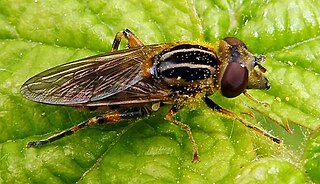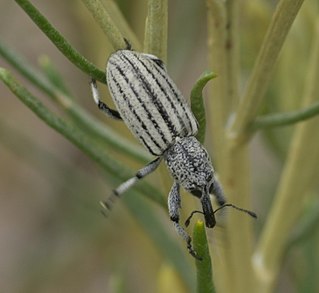
The Pholcidae are a family of araneomorph spiders. The family contains over 1,800 pholcids, including those commonly known as the marbled cellar spider , daddy long-legs spider, granddaddy long-legs spider, carpenter spider, daddy long-legger, vibrating spider, gyrating spider, long daddy, and skull spider. The family, first described by Carl Ludwig Koch in 1850, is divided into 94 genera.
Tarodes is a monotypic genus of jumping spiders containing the single species, Tarodes lineatus. It was first described by Reginald Innes Pocock in 1899, and is found only on the Bismarck Archipelago of New Britain. The species name lineatus means "striped" in Latin.

Myrmecotypus is a genus of ant mimicking corinnid sac spiders first described by O. Pickard-Cambridge in 1894. Species mainly occur from Panama to Mexico, with one species found in the United States, and one in Argentina.

Stegodyphus is a genus of velvet spiders that was first described by Eugène Simon in 1873. They are distributed from Africa to Europe and Asia, with two species found in Brazil. The name is derived from Ancient Greek στέγω (stegos), meaning "covered".

Stegodyphus lineatus is the only European species of the spider genus Stegodyphus. Male S. lineatus can grow up to 12 mm long while females can grow up to 15 mm. The colour can range from whitish to almost black. In most individuals the opisthosoma is whitish with two broad black longitudinal stripes. Males and females look similar, but the male is generally richer in contrast and has a bulbous forehead. The species name refers to the black lines on the back of these spiders. S. lineatus is found in the southern Mediterranean region of Europe and as far east as Tajikistan.
Zygoballus lineatus is a species of jumping spider which occurs in Argentina. It is known only from a single female specimen collected in Tigre, Buenos Aires.

Euthynnus lineatus, the black skipjack or black skipjack tuna, is a species of ray-finned bony fish in the family Scombridae. It belongs to the tribe Thunnini, better known as the tunas.

Surface wave detection by animals is the process by which animals, such as surface-feeding fish are able to sense and localize prey and other objects on the surface of a body of water by analyzing features of the ripples generated by objects' movement at the surface. Features analyzed include waveform properties such as frequency, change in frequency, and amplitude, and the curvature of the wavefront. A number of different species are proficient in surface wave detection, including some aquatic insects and toads, though most research is done on the topminnow/surface killifish Aplocheilus lineatus. The fish and other animals with this ability spend large amounts of time near the water surface, some just to feed and others their entire lives.

Oxyopes lineatus is a species of spider in the family Oxyopidae, the so-called lynx spiders.

The red-shouldered hawk is a medium-sized hawk. Its breeding range spans eastern North America and along the coast of California and northern to northeastern-central Mexico. It is a permanent resident throughout most of its range, though northern birds do migrate, mostly to central Mexico. The main conservation threat to the widespread species is deforestation.

Hedriodiscus is a genus of soldier flies in the family Stratiomyidae. There are more than 20 described species in Hedriodiscus.
Ameletus lineatus is a species of combmouthed minnow mayfly in the family Ameletidae. It is found in North America.

Hypselonotus lineatus is a species of leaf-footed bug in the family Coreidae. It is found in Central America, North America, South America, and Mexico.

Hypselonotus is a genus of leaf-footed bugs in the family Coreidae. There are about 12 described species in Hypselonotus.

Castolus is a genus of assassin bugs in the family Reduviidae. There are about 16 described species in Castolus.

Lopheros is a genus of net-winged beetles in the family Lycidae. There are about eight described species in Lopheros.
Helophorus lineatus is a species of water scavenger beetle in the family Hydrophilidae. It is found in North America.
Ochthebius lineatus is a species of minute moss beetle in the family Hydraenidae. It is found in Central America, North America, and South America.

Lejops lineatus is a species of syrphid fly in the family Syrphidae.

Myrmex lineatus is a species of antlike weevil in the beetle family Curculionidae. It is found in North America.













